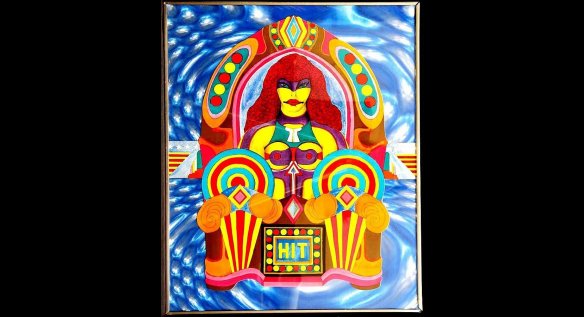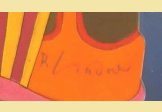Hit
| Artist | : | Richard Lindner |
| Medium | : | Lithograph |
| Size unframed | : | 19"/27" |
| Size framed | : | N/A |
| Signature Info | : | Hand Signed - Signed and numbered in pencil by the artist |
| Frame Info | : | Not Framed |
| Condition | : | Excellent |
| Year | : | 1971 |
Description
This is a collage on heavy paper of lithograph elements, by Richard Lindner (German/American - 1901-1978). "Hit" from the "Fun City", mounted on a Blue Rolux board, 1971 signed and numbered in pencil by the artist.
It is numbered LXIII from the set of 75 in Roman Numbers for distribution outside the U.S. (total recorded edition 291), as published by Shorewood Publishers, Inc., New York.
Condition Report: In fine condition, the colours very fresh, never framed. The Rowlux in the original edge held carrier protected by Plexiglas and therefore is without any scratches. Paper with very slight toning from age.
Dimensions: Size info: sheet: 25 by 19 1/2 in. (63 1/2 x 49.5 cm.) sold unframed.
Please note that it is not the more common Lithograph, but a rare Collage.
-
Artist: Richard Lindner
-
Title: "Hit"
-
Medium: Collage
-
Year: 1971
-
Edition 75 & 291 Total
-
Size: 25 in x 19 1/2 in
-
Signature: Hand signed, & numbered by artist
Richard Lindner, German/American (1901 - 1978)
Painter Richard Lindner's highly idiosyncratic work incorporates elements of his personal history, as well as literary associations. The element of introspection separates his work from pop art.
He was born in Hamburg, Germany in 1901 to an American mother and a German father. After a brief career as a concert pianist, in 1925 Lindner entered the Academy of Fine Arts in Munich. Eventually, he became an art director for Knorr & Hirth, a publisher closely associated with the Nazis. There, Lindner met high-ranking Nazis, including Hitler.
The day after the Nazis came to power in 1933, he fled to Paris, where he was imprisoned. To prove his loyalty, he served in the French and British armies. Finally, in 1941, he arrived in New York City.
Liudner worked as an illustrator for Vogue, Fortune and Harper's Bazaar. He began painting seriously in 1952, holding his first one-man exhibit in 1954. His style blends a mechanistic cubism with personal images and haunting symbolism.
He used flat areas of rich, sometimes garish, colors separated by hard edges, to present ambiguous perspective. He modeled clothing, faces and body parts.
His favorite subject was bizarre women. Corsets and straps emphasize their sexual qualities. Lindner professed no hatred of women; instead, he said, "I feel sorry for women. When I dress women in these corsets and contraptions in my painting, it's kind of the way I see them wrapping themselves up."
His Ice (1966, Whitney Museum of American Art) established a connection between the metaphysical tradition and pop art. The painting shows harsh, flat geometric shapes framing an erotic but mechanical robot-woman.
Lindner's characters-the women, precocious children and men who could be strangers or voyeurs--often are posed in slice-of-life scenes. But these scenes are obsessive, rather than normal visions.
Though he became a United States citizen in 1948, Lindner considered himself a New Yorker, but not a true American. However, over the course of time, his continental circus women became New York City streetwalkers. New York police uniforms replaced European military uniforms as symbols of authority.
Lindner taught at the Pratt Institute from 1952 to 1965. He died in 1978.



